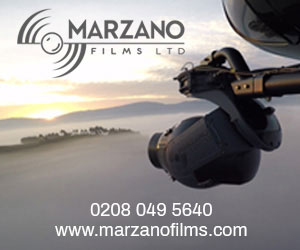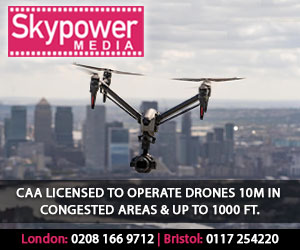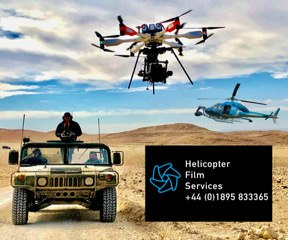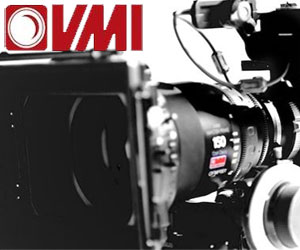Broadcast News
25/07/2016
Stabilization, Some Basics
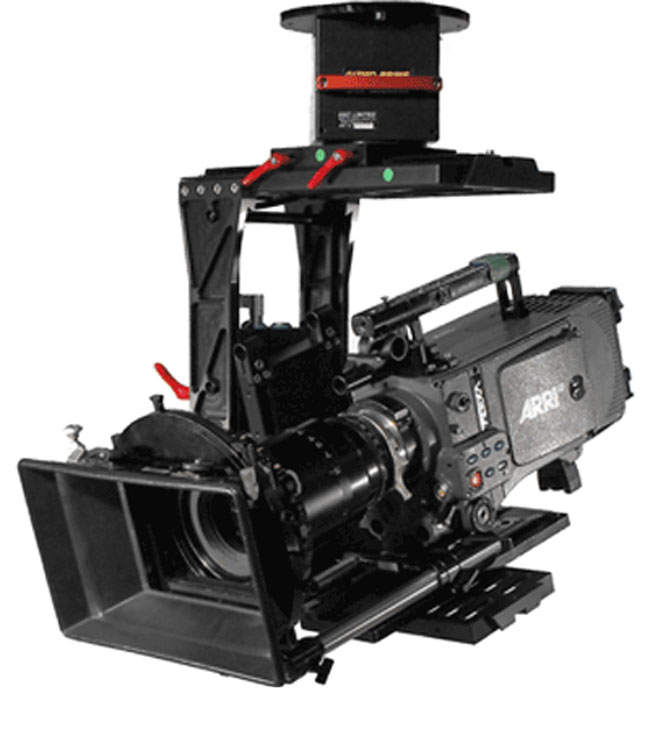
As manufacturers of stabilized systems we are often meeting people who are considering either purchase or use of stabilization and have had limited practical experience with this type of mounting. This article is an attempt to cover some of the basics. By Frank Fletcher, Managing Director, A&C Ltd.
Stabilization of Camera Platforms or Remote Heads is an extremely complex, and at times difficult, task. As a manufacturer of stabilized systems my opinions must of course have a bias towards my own systems, but I have genuinely tried to give a fair overview of the subject.
There are many stabilized camera platforms to choose from. The majority are three axis, Pan, Tilt & Roll (sometimes called Yaw). Some systems offer more than three axis; I have concentrated on three axis systems (although many of the points covered apply to the other systems).
This article also only deals with 'Ground Based Systems' that are generally used by Camera Equipment rental houses. This is often where a variety of camera and lens packages must be accommodated and changed in limited time scales.
Stabilized systems are complex and do have their limitations. These are some of the important characteristics and conditions that you should keep in mind when considering stabilization.
Stabilization doesn't do everything
These systems will only correct for angular movement and not parallel movement. A stabilized head mounted on a building elevator (or lift) cannot compensate for the lift as it travels up and down. This is because the movement is parallel. If a stabilized head were to be mounted at the top of a mast on a sail boat, then the swaying of the mast would be compensated for and corrected, but the up and down movement of the waves would be largely ignored by the stabilization. Failing to understand this limitation will lead to dissatisfaction by some of the operators and other production members.
Systems are limited to the speed of the response
Stabilized heads can react very quickly to correct unwanted camera movements. Ideally the compensation movements should be instant and be able to cope with any speed or frequency needed to correct the load. In reality this is not the case. Stabilization systems are limited by their bandwidth or frequency response and some really fast movements needed to correct the camera's position are often not within the systems capabilities. This lag becomes more apparent when using longer lenses that are magnifying the image.
One of the ways that this is dealt with is by the use of isolation damping devices. These 'Iso-Damp' systems sit between the head and the mounting point. They soak up the fast unwanted movements, leaving the stabilization with unwanted movements that are slower and within the bandwidth of the system. These Iso-Damp devices have many different designs and qualities and their choice is as important as the stabilized head itself. Some Iso-Dampers look like they are using springs in their construction but springs would be counterproductive and the spring-like devices are in fact friction type dampers. Iso-Damping systems also serve another purpose; they decouple the head from some of the mounting point's resonance and flexing.
Drift
Drift is the system's unwanted movement that is usually caused by the Gyros and is normally measured in degrees per hour over the operating temperature range. The better systems have very small amounts of drift that would only be noticed whilst the head is stationary over a long period of time. How this drift is compensated for and adjusted is an important feature.
Roll Issues
There are certain conditions where the Roll axis can move off from its position when the head is being panned quickly or the head is on a crane or camera car that is undergoing fast turns. The cause of this unwanted movement is complex and often requires the operator to either turn off the Roll stabilization or compensate for this unwanted movement through the controls. Some stabilized heads have addressed this issue and no operator compensation is necessary.
Cameras and Lenses need to be as rigid as possible
The ideal load would be completely rigid without any flexing (like a block of granite rock). Reduction of flexing or bending of the camera and lens package and flexing of the remote head chassis are critical. The load should be as rigid as possible as any flexing can cause the stabilization to become unstable causing the head to vibrate or oscillate, giving the system the characteristic of a "jelly on springs".
There are many ways to brace the load using brackets and support bars. Lenses, Matte Boxes and Film Magazines are all possible areas of flexing. Every attempt to reduce or eliminate this flexing should be made. Some stabilized systems are used with a single camera/lens package that is rarely changed and many hours can been spent in bracing and balancing the setup. This is a luxury rarely afforded to a system required to have the camera/lens package changed frequently.
Where a stabilized head is used with many different camera/lens packages, it is not always possible or practical to obtain perfect conditions regarding rigidity and balance. This may cause the load to become unstable and it will shake and oscillate when the stabilization is active. In these situations, adjusting the stabilization parameters to give a compromise in reaction or performance is necessary.
These adjustments are sometimes called 'Tuning' (or adjusting PID settings). There are up to eight parameters that need to be adjusted to give the correct performance on each axis. You will quickly begin to realise that the number of possible tuning settings on each axis is astronomical and although there are some formulas to assist in calculating the relationship of a few of the parameters to the other parameters, it is still an exceptionally complex 'Black Art' that even Dumbledore would struggle with. The adjustments of these tuning settings are often the reason that the system is successful or unsuccessful.
Different manufactures deal with tuning in different ways. Our systems use a number of pre-sets (like the buttons on a car radio used to change stations) that simplify the process and hopefully speed up the set-up.
Balancing the Load
An unbalanced load will place more strain on the servo drive systems the head uses to move the load and will sometimes increase the possibility of the load becoming unstable. Balancing the load is more critical on some systems than others.
What the head is mounted on, effects its performance
Some systems move or steer relative to inertial space but most of the systems we are looking at, steer or move in relation to whatever they are mounted to. This means that when the head tries to move, it pushes back against the mount and will be transmitting forces or torque back through its mounting point.
The total mass of the head and its load are an important consideration when choosing how and where to mount it. This torque is changing its direction and amplitude in varying amounts. The more solid the mount, the easier it is for the system to perform well. Sometimes even the levelling linkage on a camera crane will have play or backlash that allows the mounting point to move a small amount when loads are reversed. This will limit the effectiveness of the stabilization.
Often increasing the mass or weight of the mounting point that the stabilized head is fixed to, will help to improve performance. Using the right sort of Iso-Damp will always be an important factor in reducing these problems.
Some recommendations
The performance in the different systems varies enormously. The ease of use is also very different. A significant factor in the successful use of any stabilized head can be the technician setting up the equipment.
Where the lens used is fairly wide, then the demands on the system are easier but where the lenses are long, with a much greater degree of magnification, the demands made on the stabilization are more taxing.
It is unlikely that any one system will be able to handle all of the different camera packages and shot requirements with equally good results. When choosing a stabilization system, make sure that you take a pragmatic approach to deciding what sort of loads it must carry and avoid over specifying your requirements. Be sure the right people understand what the system will and won't do.
Take your time to get to know the manufacture and find out what support is available.
Without properly trained technicians, any stabilized system is a wasted investment.
Please remember that this is not intended to be a definitive guide but just a general overview or place to start understanding stabilization. My apologies to any 'real' expert who reads this and thinks I've missed something important out.
If you want to read a truly detailed description of Stabilization as it applies to Film & TV, I strongly recommend the following; Stabilization, Steering, and Gimbal Technology as it relates to Cinematography by Mike Lewis, Director of Technology, PV-Labs Inc.
Article by Frank Fletcher, Managing Director, A&C Ltd.
www.powerpod.co.uk
(JP/MH)
Stabilization of Camera Platforms or Remote Heads is an extremely complex, and at times difficult, task. As a manufacturer of stabilized systems my opinions must of course have a bias towards my own systems, but I have genuinely tried to give a fair overview of the subject.
There are many stabilized camera platforms to choose from. The majority are three axis, Pan, Tilt & Roll (sometimes called Yaw). Some systems offer more than three axis; I have concentrated on three axis systems (although many of the points covered apply to the other systems).
This article also only deals with 'Ground Based Systems' that are generally used by Camera Equipment rental houses. This is often where a variety of camera and lens packages must be accommodated and changed in limited time scales.
Stabilized systems are complex and do have their limitations. These are some of the important characteristics and conditions that you should keep in mind when considering stabilization.
Stabilization doesn't do everything
These systems will only correct for angular movement and not parallel movement. A stabilized head mounted on a building elevator (or lift) cannot compensate for the lift as it travels up and down. This is because the movement is parallel. If a stabilized head were to be mounted at the top of a mast on a sail boat, then the swaying of the mast would be compensated for and corrected, but the up and down movement of the waves would be largely ignored by the stabilization. Failing to understand this limitation will lead to dissatisfaction by some of the operators and other production members.
Systems are limited to the speed of the response
Stabilized heads can react very quickly to correct unwanted camera movements. Ideally the compensation movements should be instant and be able to cope with any speed or frequency needed to correct the load. In reality this is not the case. Stabilization systems are limited by their bandwidth or frequency response and some really fast movements needed to correct the camera's position are often not within the systems capabilities. This lag becomes more apparent when using longer lenses that are magnifying the image.
One of the ways that this is dealt with is by the use of isolation damping devices. These 'Iso-Damp' systems sit between the head and the mounting point. They soak up the fast unwanted movements, leaving the stabilization with unwanted movements that are slower and within the bandwidth of the system. These Iso-Damp devices have many different designs and qualities and their choice is as important as the stabilized head itself. Some Iso-Dampers look like they are using springs in their construction but springs would be counterproductive and the spring-like devices are in fact friction type dampers. Iso-Damping systems also serve another purpose; they decouple the head from some of the mounting point's resonance and flexing.
Drift
Drift is the system's unwanted movement that is usually caused by the Gyros and is normally measured in degrees per hour over the operating temperature range. The better systems have very small amounts of drift that would only be noticed whilst the head is stationary over a long period of time. How this drift is compensated for and adjusted is an important feature.
Roll Issues
There are certain conditions where the Roll axis can move off from its position when the head is being panned quickly or the head is on a crane or camera car that is undergoing fast turns. The cause of this unwanted movement is complex and often requires the operator to either turn off the Roll stabilization or compensate for this unwanted movement through the controls. Some stabilized heads have addressed this issue and no operator compensation is necessary.
Cameras and Lenses need to be as rigid as possible
The ideal load would be completely rigid without any flexing (like a block of granite rock). Reduction of flexing or bending of the camera and lens package and flexing of the remote head chassis are critical. The load should be as rigid as possible as any flexing can cause the stabilization to become unstable causing the head to vibrate or oscillate, giving the system the characteristic of a "jelly on springs".
There are many ways to brace the load using brackets and support bars. Lenses, Matte Boxes and Film Magazines are all possible areas of flexing. Every attempt to reduce or eliminate this flexing should be made. Some stabilized systems are used with a single camera/lens package that is rarely changed and many hours can been spent in bracing and balancing the setup. This is a luxury rarely afforded to a system required to have the camera/lens package changed frequently.
Where a stabilized head is used with many different camera/lens packages, it is not always possible or practical to obtain perfect conditions regarding rigidity and balance. This may cause the load to become unstable and it will shake and oscillate when the stabilization is active. In these situations, adjusting the stabilization parameters to give a compromise in reaction or performance is necessary.
These adjustments are sometimes called 'Tuning' (or adjusting PID settings). There are up to eight parameters that need to be adjusted to give the correct performance on each axis. You will quickly begin to realise that the number of possible tuning settings on each axis is astronomical and although there are some formulas to assist in calculating the relationship of a few of the parameters to the other parameters, it is still an exceptionally complex 'Black Art' that even Dumbledore would struggle with. The adjustments of these tuning settings are often the reason that the system is successful or unsuccessful.
Different manufactures deal with tuning in different ways. Our systems use a number of pre-sets (like the buttons on a car radio used to change stations) that simplify the process and hopefully speed up the set-up.
Balancing the Load
An unbalanced load will place more strain on the servo drive systems the head uses to move the load and will sometimes increase the possibility of the load becoming unstable. Balancing the load is more critical on some systems than others.
What the head is mounted on, effects its performance
Some systems move or steer relative to inertial space but most of the systems we are looking at, steer or move in relation to whatever they are mounted to. This means that when the head tries to move, it pushes back against the mount and will be transmitting forces or torque back through its mounting point.
The total mass of the head and its load are an important consideration when choosing how and where to mount it. This torque is changing its direction and amplitude in varying amounts. The more solid the mount, the easier it is for the system to perform well. Sometimes even the levelling linkage on a camera crane will have play or backlash that allows the mounting point to move a small amount when loads are reversed. This will limit the effectiveness of the stabilization.
Often increasing the mass or weight of the mounting point that the stabilized head is fixed to, will help to improve performance. Using the right sort of Iso-Damp will always be an important factor in reducing these problems.
Some recommendations
The performance in the different systems varies enormously. The ease of use is also very different. A significant factor in the successful use of any stabilized head can be the technician setting up the equipment.
Where the lens used is fairly wide, then the demands on the system are easier but where the lenses are long, with a much greater degree of magnification, the demands made on the stabilization are more taxing.
It is unlikely that any one system will be able to handle all of the different camera packages and shot requirements with equally good results. When choosing a stabilization system, make sure that you take a pragmatic approach to deciding what sort of loads it must carry and avoid over specifying your requirements. Be sure the right people understand what the system will and won't do.
Take your time to get to know the manufacture and find out what support is available.
Without properly trained technicians, any stabilized system is a wasted investment.
Please remember that this is not intended to be a definitive guide but just a general overview or place to start understanding stabilization. My apologies to any 'real' expert who reads this and thinks I've missed something important out.
If you want to read a truly detailed description of Stabilization as it applies to Film & TV, I strongly recommend the following; Stabilization, Steering, and Gimbal Technology as it relates to Cinematography by Mike Lewis, Director of Technology, PV-Labs Inc.
Article by Frank Fletcher, Managing Director, A&C Ltd.
www.powerpod.co.uk
(JP/MH)
More Broadcast Cameras and Camera Equipment Stories
21/06/2019
ARRI Unveils New ALEXA Mini LF Camera
ARRI has unveiled its new ALEXA Mini LF camera. Combining the compact size and low weight of the popular ALEXA Mini with the large-format ALEXA LF sen
ARRI Unveils New ALEXA Mini LF Camera
ARRI has unveiled its new ALEXA Mini LF camera. Combining the compact size and low weight of the popular ALEXA Mini with the large-format ALEXA LF sen
18/06/2019
Sony's 4K HDR Professional Camcorders To Receive Additional Workflow Flexibility
Sony has announced that its palm-sized 4K HDR professional camcorders, HXR-NX80 and PXW-Z90, will receive additional workflow flexibility via a free f
Sony's 4K HDR Professional Camcorders To Receive Additional Workflow Flexibility
Sony has announced that its palm-sized 4K HDR professional camcorders, HXR-NX80 and PXW-Z90, will receive additional workflow flexibility via a free f
29/03/2019
Vinten Unveils Two Additions To Its Range Of Robotic Solutions
Vinten has unveiled two additions to its range of robotic solutions for broadcast studios. These include a new virtual reality/augmented reality (VR/A
Vinten Unveils Two Additions To Its Range Of Robotic Solutions
Vinten has unveiled two additions to its range of robotic solutions for broadcast studios. These include a new virtual reality/augmented reality (VR/A
26/03/2019
Disney Benefits From Cooke Optics' Anamorphic/i Lenses
Two VFX-heavy commercial spots for Disney highlighting the latest Star Wars toys and merchandise benefited from Cooke Optics' Anamorphic/i prime lense
Disney Benefits From Cooke Optics' Anamorphic/i Lenses
Two VFX-heavy commercial spots for Disney highlighting the latest Star Wars toys and merchandise benefited from Cooke Optics' Anamorphic/i prime lense
09/04/2018
Sony FS5 II Now Supports Apple ProRes RAW
Atomos has announced that the Sony FS5 II with the Shogun Inferno 7" HDR monitor/recorder now supports Apple ProRes RAW. There are now nine ProRes com
Sony FS5 II Now Supports Apple ProRes RAW
Atomos has announced that the Sony FS5 II with the Shogun Inferno 7" HDR monitor/recorder now supports Apple ProRes RAW. There are now nine ProRes com
05/04/2018
A Filmmaker's Guide To Sensor Sizes And Lens Formats
As a cinematographer who owns lenses designed for various formats, I am often asked "will this lens work with my camera?" or, "will this lens cover 8K
A Filmmaker's Guide To Sensor Sizes And Lens Formats
As a cinematographer who owns lenses designed for various formats, I am often asked "will this lens work with my camera?" or, "will this lens cover 8K
12/03/2018
Cooke Optics Reveals New Focal Lengths
The next focal lengths have been announced by Cooke Optics for its latest lens ranges. The S7/i purpose-built full frame lens range is to include a 16
Cooke Optics Reveals New Focal Lengths
The next focal lengths have been announced by Cooke Optics for its latest lens ranges. The S7/i purpose-built full frame lens range is to include a 16
12/03/2018
Sony Ships VENICE Full-Frame Motion Picture Camera System
Sony's much-anticipated VENICE – its next-generation CineAlta motion picture camera – has commenced shipping to customers. As previously
Sony Ships VENICE Full-Frame Motion Picture Camera System
Sony's much-anticipated VENICE – its next-generation CineAlta motion picture camera – has commenced shipping to customers. As previously
15/02/2018
Anamorphic Lens Choices For 2018
The popularity of shooting with Anamorphic lenses has seen increased interest. This has expressed itself not only in the demand for established produc
Anamorphic Lens Choices For 2018
The popularity of shooting with Anamorphic lenses has seen increased interest. This has expressed itself not only in the demand for established produc
14/02/2018
Historical Vignettes Lensed with Cooke S4/i Primes
For the historical vignettes in the upcoming CNN six-hour, six-part miniseries Pope: The Most Powerful Man in History, Dane Lawing, SOC wanted each er
Historical Vignettes Lensed with Cooke S4/i Primes
For the historical vignettes in the upcoming CNN six-hour, six-part miniseries Pope: The Most Powerful Man in History, Dane Lawing, SOC wanted each er








